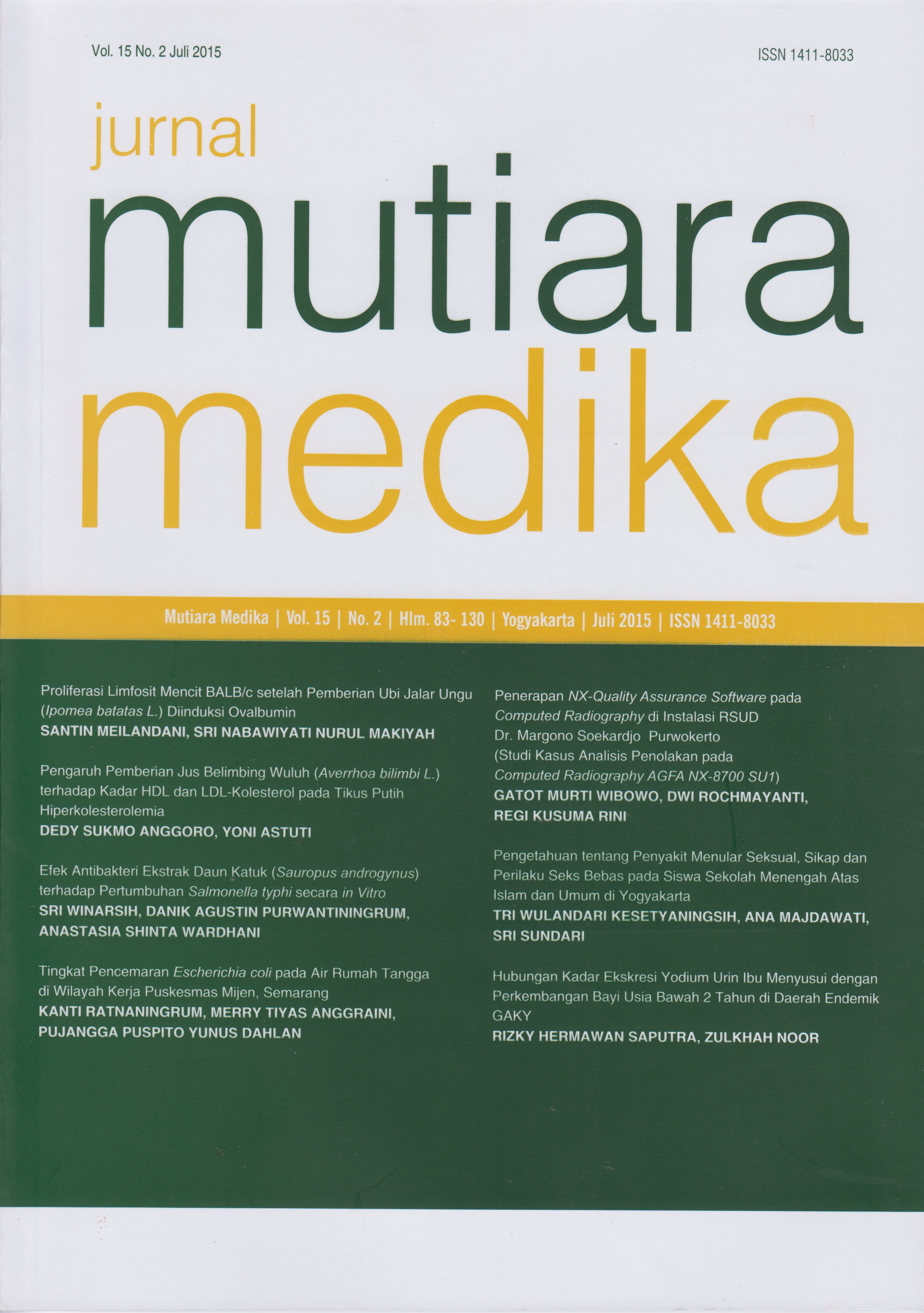Penerapan NX-Quality Assurance Software pada Computed Radiography di Instalasi RSUD Dr. Margono Soekardjo Purwokerto (Studi Kasus Analisis Penolakan pada Computed Radiography AGFA NX-8700 SU1)
DOI:
https://doi.org/10.18196/mmjkk.v15i2.3757Keywords:
reject analysis of softcopy image, NX-Quality Assurance software, computed radiography, pareto chart, fishbone diagram, analisis penolakan citra softcopy, diagram pareto, diagram fishboneAbstract
Program Reject Analysis merupakan bagian dari program Quality Assurance yang berguna untuk meningkatkan kualitas pelayanan rumah sakit bidang diagnostik. Tujuan penelitian ini adalah untuk memaparkan hasil analisis penolakan citra softcopy, menjelaskan faktor penyebab penolakan dan rekomendasi pemecahan masalah untuk mengurangi angka penolakan citra softcopy. Jenis penelitian ini kuantitatif analitik dan kualitatif menggunakan metode focus group discussion (FGD). Data unduhan yang diperoleh dari NX-Quality Assurance software kemudian diolah untuk mengetahui persentase penolakan kemudian dirinci berdasarkan penyebab penolakan, jenis pemeriksaan dan kode radiografer selanjutnya dibuat diagram pareto untuk mencari prioritas penolakan dan dibuat diagram fishbone berdasarkan hasil FGD. Hasil penelitian menunjukkan total reject rate pada bulan Maret 2014 sebesar 3,02%, melampaui batas yang direkomendasikan Kemenkes yaitu d” 2%. Faktor utama penyebab penolakan adalah faktor positioning (69,69%), jenis pemeriksaan chest (43,94%) dan radiografer mahasiswa (21%-24,24%). Solusinya adalah mengadakan briefing rutin setiap hari oleh radiografer secara bergantian kepada mahasiswa praktikan disertai dengan pemberian tips sederhana dalam melakukan pemeriksaan sesuai pengalaman radiografer, mengadakan gladi lapangan terhadap praktikan baru untuk orientasi atau pengenalan alat, meningkatkan keterampilan mahasiswa dengan memberikan shift tambahan terhadap mahasiswa di luar PKL dan membangun komunikasi terhadap pasien serta meningkatkan pengetahuan tentang teknik pemeriksaan.The Reject Analysis program is part of the Quality Assurance program that is useful for improving the quality of diagnostic hospital services. The purpose of this research is to describe the result of softcopy image rejection analysis, explain the cause of rejection factor and problem solving recommendation to reduce the softcopy image rejection number. This type of research is quantitative analytic and qualitative using focus group discussion method (FGD). The download data obtained from the NX-Quality Assurance software is then processed to determine the percentage of rejection then specified based on the cause of the rejection, the type of examination and the radiographic code is then made a pareto diagram to seek priority rejection and made a fishbone diagram based on FGD results. The results showed the total reject rate in March 2014 was 3.02%, exceeding the Ministry of Health’s recommendation that is d” 2%. The main factors causing rejection are positioning factor (69,69%), chest examination type (43,94%) and student radiographer (21% -24,24%). The solution is to hold daily routine briefing by radiographer in turns to the student accompanied by the provision of simple tips in conducting examination according to the experience of radiographer, conducting a field rehearsal of new practitioners for orientation or introduction of tools, improving student skills by providing additional shifts to students outside the street vendors and build communication to patients as well as improve knowledge of examination
References
Ballinger, PW. dan Eugene D.F. Merril’s Atlas of Radiographic Positions and Radiologic Procedures, Tenth Edition, Volume Three. Saint Louis : Mosby. 2003.
Greene, E.R dan Jorg WO. Computed Digital Radiography in Clinical Practice. New York: Thieme Medical Publishers. 1992.
Papp, J. Quality Management in The Imaging Science. Third Edition. Saint Louis : Mosby. 2006.
KMK Nomor 129/Menkes/SK/II/2008 Tentang Standar Pelayanan Minimal Rumah Sakit
Downloads
Issue
Section
License
Copyright
Authors retain copyright and grant Mutiara Medika: Jurnal Kedokteran dan Kesehatan (MMJKK) the right of first publication with the work simultaneously licensed under an Attribution 4.0 International (CC BY 4.0) that allows others to remix, adapt and build upon the work with an acknowledgment of the work's authorship and of the initial publication in Mutiara Medika: Jurnal Kedokteran dan Kesehatan (MMJKK).
Authors are permitted to copy and redistribute the journal's published version of the work (e.g., post it to an institutional repository or publish it in a book), with an acknowledgment of its initial publication in Mutiara Medika: Jurnal Kedokteran dan Kesehatan (MMJKK).
License
Articles published in the Mutiara Medika: Jurnal Kedokteran dan Kesehatan (MMJKK) are licensed under an Attribution 4.0 International (CC BY 4.0) license. You are free to:
- Share — copy and redistribute the material in any medium or format.
- Adapt — remix, transform, and build upon the material for any purpose, even commercially.
This license is acceptable for Free Cultural Works. The licensor cannot revoke these freedoms as long as you follow the license terms. Under the following terms:
Attribution — You must give appropriate credit, provide a link to the license, and indicate if changes were made. You may do so in any reasonable manner, but not in any way that suggests the licensor endorses you or your use.
- No additional restrictions — You may not apply legal terms or technological measures that legally restrict others from doing anything the license permits.






